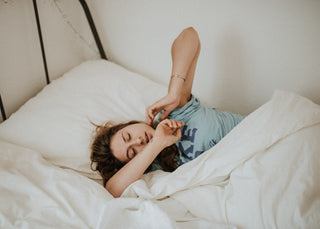HOW WEIGHTED BLANKET THERAPY CAN HELP THOSE WITH ANXIETY, AUTISM, AND MORE
You’re awake, tossing around in your blankets, and no matter how long or hard you shut your eyes, you can’t seem to fall asleep. Thoughts race: What if I mess up my presentation at work tomorrow? Did I forget to pay my student loan? Did I turn off the oven? Worries scamper through your brain, and before you know it, your alarm is going off and you haven’t gotten an ounce of sleep. Insomnia and disrupted sleeping patterns can come from many sources, such as a tough day at work, but more serious conditions, like autism spectrum disorder (ASD) and sensory processing disorder (SPD), can also be triggers.
Of course, there are medications out there designed to help with insomnia and anxiety. Some people prefer not to take them, perhaps because of the side effects or because they don’t help the way they should. There are some medications and therapies available for ASD and SPD as well, and like those for insomnia, these options don’t always pan out. One therapy, however, comes relatively cheap and with virtually no side effects. It’s also capable of helping people with these conditions, and maybe even more. Hemp bedding products
SENSING THE PRESSURE
On the surface, something as simple as a weighted blanket shouldn’t be able to hold its own against extensively researched and designed drugs. Even therapies designed to relieve anxiety or alleviate certain ASD symptoms take many years of study and practice. How, then, could a heavy blanket help these patients out?
The idea of weighted-blanket therapy, also called deep-touch therapy, goes back to a basic human behaviour known to calm us — being held. Clinical studies suggest that when certain pressure points on the body are stimulated by touch, the brain releases serotonin. This neurotransmitter is responsible for regulating various brain functions, including sleep and mood.
“Historically, Native Americans and other indigenous tribes from around the world automatically wrapped their babies snuggly in a swaddle or cradle board to ease fussiness,” Tori Boucher, an autism spectrum counsellor and author told Medical Daily via email. “Innovative hospitals and birthing centres today continue this practice. Weighted blankets are a clever extension of that idea for individuals who continue to need snug pressure beyond infancy.”
The key to this stimulation is the heaviness of the blanket, which is able to create a deep pressure. Aside from swaddles, this kind of pressure is present in hugs and when we stroke animals.
“In contrast, light touch pressure is a more superficial stimulation of the skin, such as tickling, very light touch, or moving hairs on the skin,” wrote Dr. Temple Grandin in the Journal of Child and Adolescent Psychopharmacology. “In animals, the tickle of a fly landing on the skin may cause a cow to kick, but the firm touch of the farmer’s hands quiets her. Occupational therapists have observed that a very light touch alerts the nervous system, but deep pressure is relaxing and calming.”
A MULTI-USE THERAPY
At first, deep touch pressure stimulation was used to help children with ASD or SPD. These kids often experience sensory overload, meaning they have difficulty filtering out background sensory information. This can cause restlessness, anxiety, and trouble participating in seated activities and ongoing tasks. Of course, sleeping can be difficult in this state as well.
Studies have shown weighted blankets can help children with ASD fall asleep. The kids benefit not only from the release of serotonin the blankets bring, but also from the decrease in heart rate and blood pressure that result from the calming effect. This allows for more control, and in turn, a better chance of rest.
Weighted blankets and deep-touch pressure benefits those without a specific sensory disorder as well. One 2004 study involved participants complaining of sleep dysfunction, stress, and pain, and showed a reduction in nighttime cortisol levels while patients were “grounded” during sleep with weighted blankets. A reduction in cortisol, the primary stress hormone, lead to overall better sleep quality.
Another paper found that 63 percent of the study participants reported lower anxiety after using a weighted blanket, a benefit that has been verified by subsequent papers. Since the therapy is safe, patients with a multitude of conditions have given weighted blankets a shot — and they’ve benefited those with post-traumatic stress disorder, obsessive-compulsive disorder, attention deficit hyperactivity disorder, and all types of anxiety.
Like any medication or therapy, deep pressure stimulation doesn’t help everyone. But as a therapy with virtually no side effects or dangers — except perhaps for those with prior respiratory or circulatory problems — weighted blankets can provide a feeling of calm and comfort that has escaped some for a long time.

